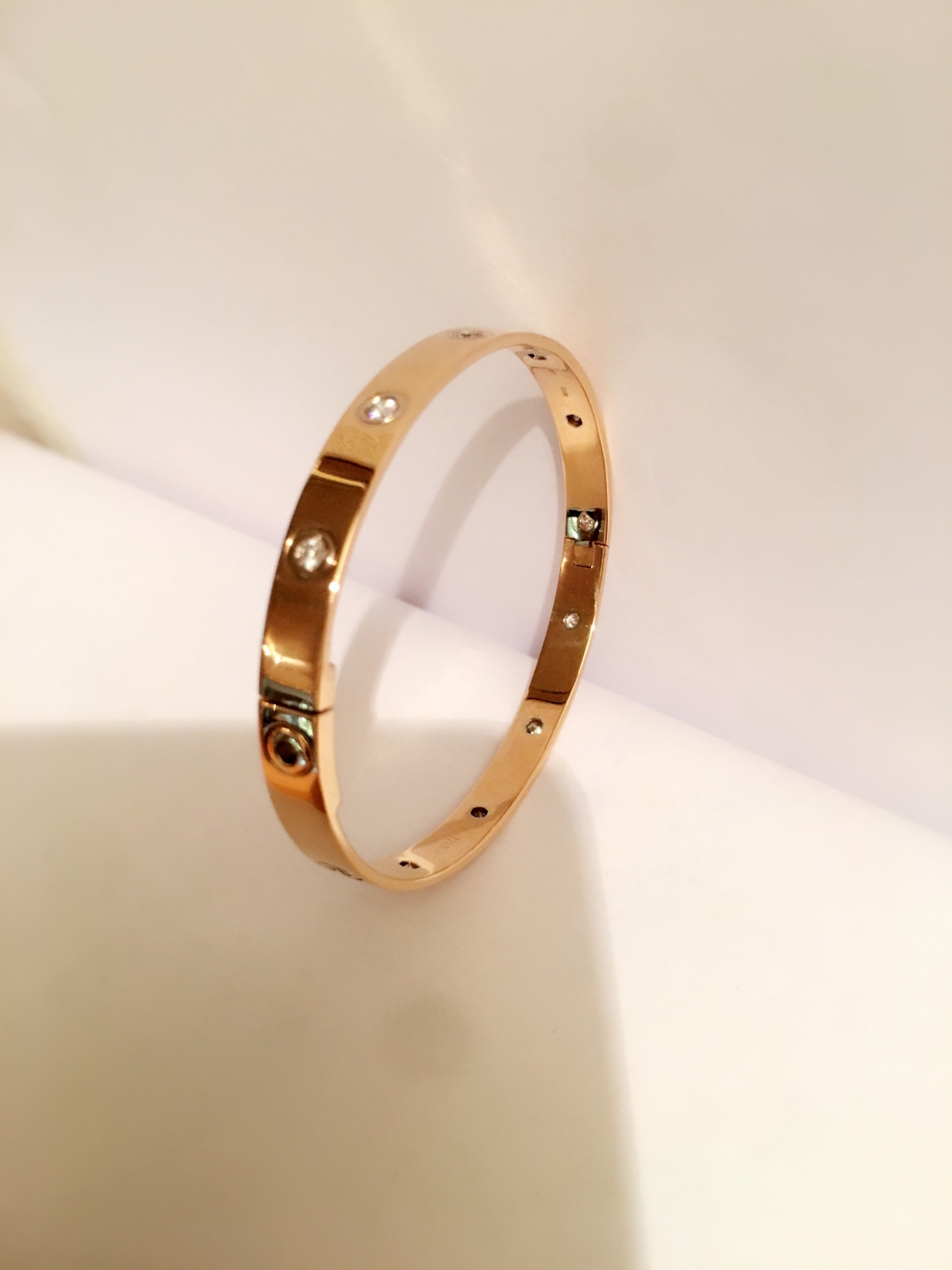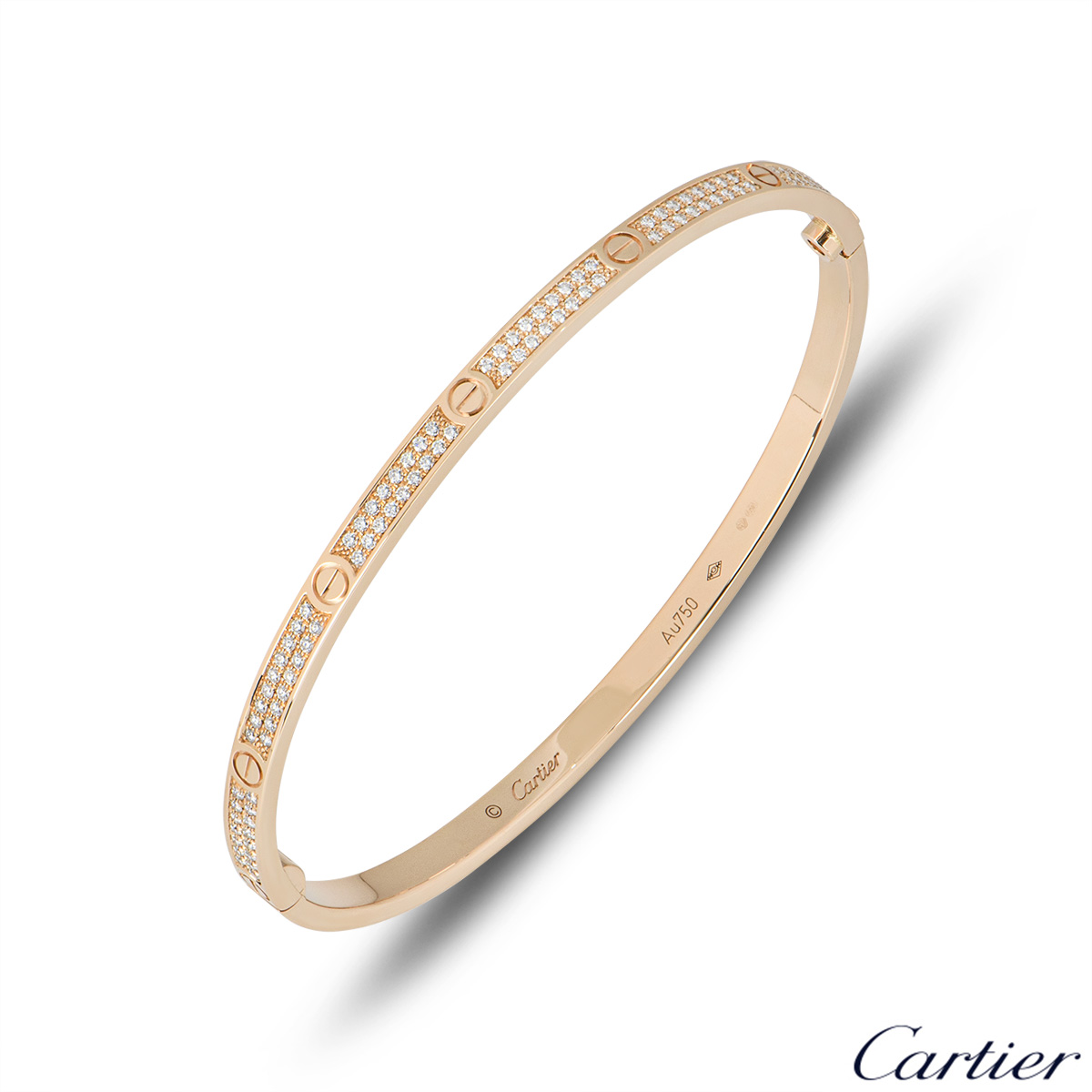
Prices for the bracelets differ depending on the items materials, and. Early versions of the Love Bracelet featured gold plating, while more recent designs are created from solid gold or platinum. The Love Bracelet (styled LVe, with the horizontal line inside the letter 'O' alluding to the bracelets locking mechanism) is a piece of jewelry designed in 1969 by Aldo Cipullo for Cartier SA.
Once you have found your size in the 'Love' column of the Bracelet Sizing Chart, Cartier recommends adding one centimetre for a tight fit and two centimetres for a looser fit. OUT OF STOCK.Various examples of jewellery throughout historyThe usual bracelet sizing rules differ slightly in this case due to the design of the LOVE bracelet. 0.0 star rating Write a review.
Jewellery may be attached to the body or the clothes. The same sizes apply to any variation of the Love bracelet.Jewellery or jewelry consists of decorative items worn for personal adornment, such as brooches, rings, necklaces, earrings, pendants, bracelets, and cufflinks. Both the small and the regular Love Bracelet come in 7 different sizes: 15 cm 16 cm 17 cm 18 cm 19 cm 20 cm 21 cm. Printing OptionsCartier Love Bracelet Sizes.
In most cultures jewellery can be understood as a status symbol, for its material properties, its patterns, or for meaningful symbols. Gemstones and similar materials such as amber and coral, precious metals, beads, and shells have been widely used, and enamel has often been important. The basic forms of jewellery vary between cultures but are often extremely long-lived in European cultures the most common forms of jewellery listed above have persisted since ancient times, while other forms such as adornments for the nose or ankle, important in other cultures, are much less common.Jewellery may be made from a wide range of materials. For many centuries metal such as gold often combined with gemstones, has been the normal material for jewellery, but other materials such as shells and other plant materials may be used.Jewellery is one of the oldest types of archaeological artefact – with 100,000-year-old beads made from Nassarius shells thought to be the oldest known jewellery.
An example of an object which is functional, artistic/decorative, marker of social status or a symbol of personal meaning.Humans have used jewellery for a number of different reasons: In French and a few other European languages the equivalent term, joaillerie, may also cover decorated metalwork in precious metal such as objets d'art and church items, not just objects worn on the person.A gold, diamonds and sapphires red guilloché enamel " Boule de Genève", a type of pendant watch used as an accessory for women. Both are used in Canadian English, though jewelry prevails by a two to one margin. In British English, Indian English, New Zealand English, Hiberno-English, Australian English, and South African English it is spelled jewellery, while the spelling is jewelry in American English. In modern European culture the amount worn by adult males is relatively low compared with other cultures and other periods in European culture.The word jewellery itself is derived from the word jewel, which was anglicised from the Old French " jouel", and beyond that, to the Latin word " jocale", meaning plaything.
Alternatively, jewellery has been used as a currency or trade good an example being the use of slave beads. Numerous cultures store wedding dowries in the form of jewellery or make jewellery as a means to store or display coins. as a carrier or symbol of personal meaning – such as love, mourning, a personal milestone or even luckMost cultures at some point have had a practice of keeping large amounts of wealth stored in the form of jewellery. to provide talismanic protection (in the form of amulets) as a signifier of some form of affiliation, whether ethnic, religious or social as a marker of social status and personal status, as with a wedding ring
Materials and methods Hair ornament, an Art Nouveau masterpiece by René Lalique circa 1902 gold, emeralds and diamonds Musée d'Orsay (Paris)In creating jewellery, gemstones, coins, or other precious items are often used, and they are typically set into precious metals. These may take the form of symbols (such as the ankh), stones, plants, animals, body parts (such as the Khamsa), or glyphs (such as stylised versions of the Throne Verse in Islamic art). Jewellery can symbolise group membership (as in the case, of the Christian crucifix or the Jewish Star of David) or status (as in the case of chains of office, or the Western practice of married people wearing wedding rings).Wearing of amulets and devotional medals to provide protection or to ward off evil is common in some cultures.
However, any inclusion of lead or lead solder will give a British Assay office (the body which gives U.K. In costume jewellery, stainless steel findings are sometimes used.Other commonly used materials include glass, such as fused-glass or enamel wood, often carved or turned shells and other natural animal substances such as bone and ivory natural clay polymer clay Hemp and other twines have been used as well to create jewellery that has more of a natural feel. The silver used in jewellery is usually sterling silver, or 92.5% fine silver.
Beads may be large or small the smallest type of beads used are known as seed beads, these are the beads used for the "woven" style of beaded jewellery. Beaded jewellery commonly encompasses necklaces, bracelets, earrings, belts and rings. These may be made of glass, gemstones, metal, wood, shells, clay and polymer clay.
Diamonds Many precious and semiprecious stones are used for jewellery. Beading, or beadwork, is also very popular in many African and indigenous North American cultures.Silversmiths, goldsmiths, and lapidaries use methods including forging, casting, soldering or welding, cutting, carving and "cold-joining" (using adhesives, staples and rivets to assemble parts). Bead embroidery, a popular type of handwork during the Victorian era, is enjoying a renaissance in modern jewellery making.
Emerald Emeralds are one of the three main precious gemstones (along with rubies and sapphires) and are known for their fine green to bluish green colour. It is treasured for its purple hue, which can range in tone from light to dark. Amethyst Amethyst has historically been the most prized gemstone in the quartz family. The stone must be at least one million years old to be classified as amber, and some amber can be up to 120 million years old.

A number of other gemstones, such as Amethyst and Citrine, are also part of the quartz family. Among the well-known types of quartz are rose quartz (which has a delicate pink colour), and smoky quartz (which comes in a variety of shades of translucent brown). Quartz Quartz refers to a family of crystalline gemstones of various colours and sizes.
In the United States, blue sapphire tends to be the most popular and most affordable of the three major precious gemstones (emerald, ruby, and sapphire). Fancy sapphires of various colours are also available. Sapphire The most popular form of sapphire is blue sapphire, which is known for its medium to deep blue colour and strong saturation. In Sanskrit, the word for ruby is ratnaraj, meaning king of precious stones. Rubies have been treasured for millennia. Ruby Rubies are known for their intense red colour and are among the most highly valued precious gemstones.

Satin, or matte finish reduces the shine and reflection of the jewellery, and this is commonly used to accentuate gemstones such as diamonds. High-polished jewellery is the most common and gives the metal a highly reflective, shiny look. The most common are high-polish, satin/matte, brushed, and hammered. Metal finishes For platinum, gold, and silver jewellery, there are many techniques to create finishes. Some man-made gems can serve in place of natural gems, such as cubic zirconia, which can be used in place of diamond. Others are inorganic, meaning that they are generally composed of and arise from minerals.Some gems, for example, amethyst, have become less valued as methods of extracting and importing them have progressed.


 0 kommentar(er)
0 kommentar(er)
